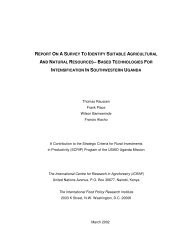Strategy for agricultural marketing and agro-processing ... - Foodnet
Strategy for agricultural marketing and agro-processing ... - Foodnet
Strategy for agricultural marketing and agro-processing ... - Foodnet
Create successful ePaper yourself
Turn your PDF publications into a flip-book with our unique Google optimized e-Paper software.
As far as access to markets is concerned, the private <strong>and</strong> public sectors play different roles but<br />
they should, nevertheless, be complementary. The private sector is responsible <strong>for</strong> the<br />
production, <strong>processing</strong> <strong>and</strong> <strong>marketing</strong> of <strong>agricultural</strong> products, while the role of the public sector<br />
is one of creating a conducive environment by drawing up appropriate policies, removing<br />
barriers at all levels, improving infrastructure <strong>and</strong> putting in place an appropriate legal <strong>and</strong><br />
regulatory framework. The MAPS highlights the priority areas in which the public sector will<br />
involve itself in order to facilitate the activities of the private sector. At the same time, it takes<br />
cognisance of the fact that there are already many initiatives underway aimed at overcoming the<br />
constraints to improved market access, while appreciating that there remain a number of areas<br />
still to be addressed. It is believed that through work being undertaken on the priority areas<br />
detailed herein, the private sector will be assisted to identify market opportunities <strong>for</strong> both<br />
<strong>marketing</strong> <strong>and</strong> value-added <strong>processing</strong>. Once such opportunities have been identified, private<br />
sector interests will be in a position to work with existing institutions <strong>and</strong> programmes in<br />
developing business plans <strong>and</strong> in selecting investment options to exploit these opportunities.<br />
Whilst the emphasis of the strategy may appear to be on <strong>marketing</strong> <strong>and</strong> <strong>processing</strong> <strong>agricultural</strong><br />
commodities <strong>for</strong> export, nevertheless the importance of the local market is implicitly recognised<br />
in this <strong>Strategy</strong>. (For example, it is clear that the focus <strong>for</strong> <strong>marketing</strong> such crops as beans <strong>and</strong><br />
Matooke bananas will remain the local market <strong>for</strong> the <strong>for</strong>eseeable future). Thus, many of the<br />
constraints <strong>and</strong> the programmes to overcome them enumerated below, apply to both the domestic<br />
<strong>and</strong> export markets.<br />
Finally, the <strong>Strategy</strong> makes no attempt to interfere with the basic laws of economics as they<br />
affect the supply, dem<strong>and</strong> <strong>and</strong> prices of <strong>agricultural</strong> commodities produced in the country but,<br />
rather, it seeks to make the market more transparent to all those actors participating in it <strong>and</strong> to<br />
remove any obstacles which impede its efficient functioning. In this way, producers will be able<br />
to compete more effectively.<br />
3
















